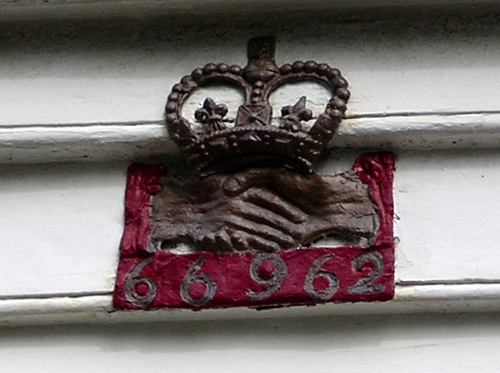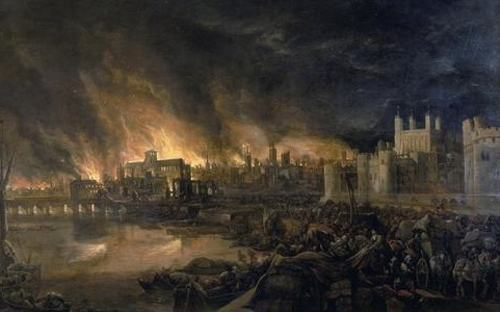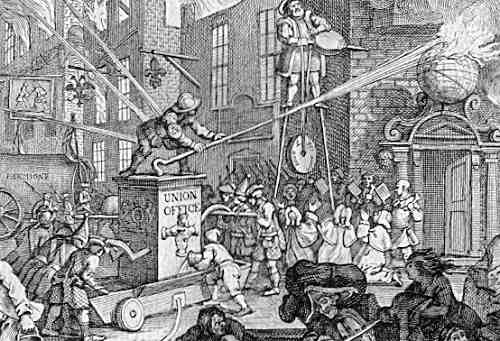The Marks of Rival Fire Brigades
- August 12, 2010
- Posted by: sajjad
- Category: Insurance History, Top Posts

Above: A fire insurance mark still stands in Dulwich.
Imagine, if you will, a fire truck racing down the road towards you as a fire engulfs your home, all of your belongings swiftly succumbing to the flames as shaken family members and neighbours watch in shock, unable to help. Thankfully the equipment-laden truck soon pulls up, a fireman exits, takes one look at your property, and states the following:
“I do apologise, but we’re unable to assist due to your policy. However the Aviva Insurance Brigade should be along in no time. Best of luck.”
Had you been alive a few hundred years ago, a scenario similar to that may well have occurred.

Above: The Great Fire of London.
Early September of 1666, over the course of just a few days, the Great Fire swept through the narrow streets of the City of London and devoured over 13’000 properties; in turn uprooting 70’000 inhabitants and instantly rendering them homeless. Just over a decade later, as the regeneration of London continued, a major figure in the process – and owner of one of the most incredible middle names of all time – identified a business opportunity amongst the ashes and formed the world’s first fire insurance company. Nicholas ‘If-Jesus-Christ-Had-Not-Died-For-Thee-Thou-Hadst-Been-Damned’ Barbon‘s company, ‘The Fire Office’, was an instant success and before long brought about the formation of numerous competitors.

Above: A Union Insurance fire brigade in action.
More interesting is this: in order to physically protect their interests and reduce losses, these early insurance companies began operating their own fire brigades, and for the next 200 hundred years – at which point they merged to form the government-run service we now depend on – competing fleets would attempt to race to each and every fire in the vicinity with a view to dampening the flames that threatened only the houses on their books. Bear in mind however, that back then very few streets and houses had names or numbers, and as such the entire process had the potential to be dangerously slow and completely unworkable. To combat the problem by offering firemen a method by which to identify ‘their’ properties, policy holders were supplied with Fire Marks – metal plaques bearing their insurance provider’s emblem and the home’s unique policy number – to attach to the front of their homes, more often than not above the front door.

Above: Three insurance companies’ fire marks.
This idea worked well enough, and upon arrival at a burning building the firemen – or ‘watermen’ as they were then more commonly known – would now almost instantly know whether they needed to begin fighting the fire, go back to the station, or, as was sometimes the case, stand by and taunt the correct team as they doused the flames. Thankfully for all involved, the insurance companies eventually realised that the often unhealthy competition was harming members of the public as well as their own businesses’ reputations, and the intense rivalry stopped. Soon enough, for a number of reasons, the brigades merged and became a municipal service.
All in all, a compelling development in both the history of insurance companies and that of the fire service which also happened to result in the design and production of nearly 1000 different fire marks, some of which can still be found above doorways in various areas.
– To learn more about the history of the insurance industry, this Wikipedia page is a good starting point. While you’re there, a glance at the history of firefighting page is also advisable.
– For more information about British fire marks and many pictures, visit Firemarks.co.uk. For an American perspective, visit The Firemark Circle of the Americas.
Images used in this article were found here, here, here and here.

